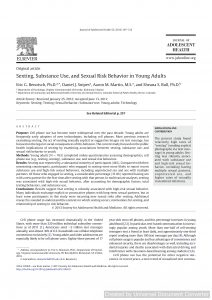Sexting
Sexting, Substance Use, and Sexual Risk Behavior in Young Adults
 Full Article Name: Sexting, Substance Use, and Sexual Risk Behavior in Young Adults
Full Article Name: Sexting, Substance Use, and Sexual Risk Behavior in Young Adults
Open Access: No
Abstract
Purpose: Cell phone use has become more widespread over the past decade. Young adults are frequently early adopters of new technologies, including cell phones. Most previous research examining sexting, the act of sending sexually explicit or suggestive images via text message, has focused on the legal or social consequences of this behavior. The current study focused on the public health implications of sexting by examining associations between sexting, substance use, and sexual risk behavior in youth. Methods: Young adults (N = 763) completed online questionnaires assessing demographics, cell phone use (e.g., texting, sexting), substance use, and sexual risk behaviors. Results: Sexting was reported by a substantial minority of participants (44%). Compared with their nonsexting counterparts, participants who engaged in sexting were more likely to report recent substance use and high-risk sexual behaviors, including unprotected sex and sex with multiple partners. Of those who engaged in sexting, a considerable percentage (31.8%) reported having sex with a new partner for the first time after sexting with that person. In multivariate analyses, sexting was associated with high-risk sexual behavior, after accounting for demographic factors, total texting behaviors, and substance use. Conclusions: Results suggest that sexting is robustly associated with high-risk sexual behavior. Many individuals exchange explicit or provocative photos with long-term sexual partners, but at least some participants in this study were incurring new sexual risks after sexting. Additional research is needed to understand the contexts in which sexting occurs, motivations for sexting, and relationship of sexting to risk behavior.
Citation
Benotsch, E. G., Snipes, D. J., Martin, A. M.,& Bull, S. S. (2013). Sexting, substance use, and sexual risk behavior in young adults. Journal of Adolescence Health, 52(3), 307-313. https://doi.org/10.1016/j.jadohealth.2012.06.011

